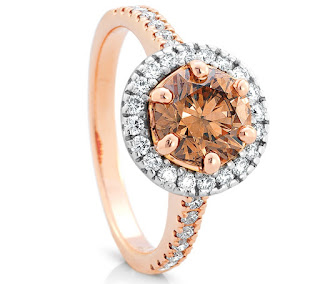Let
me introduce with the term ‘Chocolate Diamond’, well it is simply a marketing
phrase coined by the famous jewellery manufacturer Le Vian. Chocolate diamonds
are another type of brown, or cognac colored Diamond. There are two different
brown diamond i.e., natural brown diamonds, and there are those that have been colour
treated diamond. Finding a natural brown diamond isn’t an easy task, therefore,
natural colored diamonds are always going to be more expensive than those that
have been colour treated.
They
have the same properties as that of other colored diamonds. They are found in a
variety of brown shades.
Shades of chocolate diamonds:
- Chocolate
- Clove (olive-brown)
- Cognac (deep reddish-orange hue)
- Honey (deep orange-yellow)
- Champagne (warm, golden brown)
Is
it true- Chocolate Diamonds less valuable?
Usually,
yes. The vast majority of colored diamonds are now passes through color treated.
Because of the high demand of brown diamond and since this is a relatively new
product, various consumers are unaware that a large amount of brown colored
diamonds are very inferior quality. To produce any medium to high quality
colored diamond, they must use a nice quality white diamond to begin with.
Yet,
in 90 per cent of the colored diamonds they use a poor quality diamond to
treat. Why? Only because it’s cheaper, and they can get away with it. Due to
heavy marketing by chain stores, people tend not to judge a chocolate or brown
diamond in the same way they do with a white diamond. Brown diamonds are often
opaque in colour, with heavy inclusions and little sparkle, yet customers have
begun to expect this because it’s everywhere.
A
diamond with eye visible inclusions and a lack of luster will not look any
better once it’s been colour treated. An expensive white diamond is used to
make a vivid golden brown diamond, and a lower quality diamond is used to make
a less vivid chocolate, greyish brown or muddy brown diamond. Such diamonds
look like the genuine ones, but they are not valuable and have zero resale
value. You should buy the stone from a trusted jeweller only. It is also
essential to get a lab certified or certificate signifying the diamond's origin
which will prove its authenticity.
Higher
Quality Brown Diamonds
Chocolate
diamonds are mainly mined in Argyle Diamond Mine in Kimberly; and also in other
places in Russia, Africa and Australia. Although these 'low color' diamonds
were once considered as cheap or lower grade diamonds, today it is one of the
most popular diamond color shade all over the globe. Natural and Authentic
chocolate diamonds are also very rare and hence, they are very popular globally.
However, artificial ones can also be created by easy method of artificially
coloring.
 If
you want brown diamonds that have a rich golden brown colour and sparkle, or
especially if you want a larger single brown diamond, you would be better off
requesting a cognac colour. Decide what looks best to you and compare the
differences in quality, always go for best quality. If you like chocolate or
brown diamonds, by all means, buy them and enjoy them! When it comes to colored
gemstones, just be conscious of the quality you’re paying for! You must
definitely go for these diamonds. These rare, champagne-colored diamonds will
surely attract your eyes!
If
you want brown diamonds that have a rich golden brown colour and sparkle, or
especially if you want a larger single brown diamond, you would be better off
requesting a cognac colour. Decide what looks best to you and compare the
differences in quality, always go for best quality. If you like chocolate or
brown diamonds, by all means, buy them and enjoy them! When it comes to colored
gemstones, just be conscious of the quality you’re paying for! You must
definitely go for these diamonds. These rare, champagne-colored diamonds will
surely attract your eyes!



Wow, looking beautiful and getting amazed within your creative jewels within these gemstone diamond. Thank you very much for the sharing. Best astrologer in Coimbatore | Astrological gemstones in Coimbatore
ReplyDelete